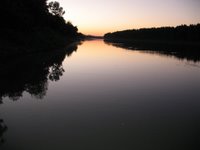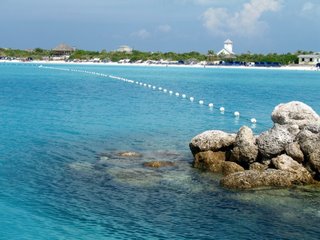It was very foggy this morning on the river.
Rusty and Lulu came by again this morning. It was a pleasure to talk to them. They stopped while running the big nets that Rusty sets out to catch buffalo. Thirty years ago I was one of them, using a mile of line and a thousand hooks to catch my fish instead of the big nets. We are very different ages, but there is a kinship that exists between commercial fisherman, one that rests upon s

haring the same kind of cold mornings, and rainstorms on the river, and lightning coming to places you can’t predict and the other things (both pleasant and not so pleasant) that make working on the river memorable. I was doing what they do now when they were learning how to read in grade school. . Even with this difference in ages, there is a shared communication that is partly language and partly just knowing that each of you has felt cold and heat and disappointment and that feeling of deep satisfaction that comes with a net full of fish, or a trotline with ten fish on in a row. All of us have that thing in the back of our minds that sees the fish you have in your boat, makes the calculations, and knows when you have done a good day’s work, and that is a very good feeling. Each day as the fish are brought to the dock and sold, there is that day’s reward in your hand, not a promise of it to be paid at the end of the month, but in your hand. Each day renews its potential to reward, and often delivers it if you put in the time and skill to earn it. But, it is a young man’s job. I do envy them, but not all the time.
Both of these men have read these postings and both approve of what has been written about them. What a marker for times changing that is! I have written words and taken digital pictures and placed them in a place that has no boundaries on the Earth. And these men have the ability sell their fish, drive their boats home, and then sit in their easy chairs and retrieve my words and pictures and evaluate what I have said. That is an astounding thing.
When I was fishing, the only computers were in very sophisticated places and were themselves very big machines. Telephones were the only established me

thod of long-range communication and not all fishermen had them. The word FAX was new and the machines that delivered a facsimile of a printed page seemed almost to be magical. Everyone who had one put the FAX number on business cards to show how up to date they were and how technologically advanced. It almost seems out of touch to put that on a card now. And now, all three of us have, or have access to, machinery and communication networks that were hardly conceivable thirty years ago, even by brains farseeing enough to imagine such things. I can write and my commercial fishermen friends can read what I have written without ever seeing a piece of paper. Rusty told me this morning that he goes to the Internet to find information about the fish he catches, to get maps of places he wants to fish and to get predictions of the river stages. And for him, now, these things are just routine. What a world!
The pictures are of various things. Napoleon encountered something that might be his Waterloo out there in the wilds. He is pretty beat up this morning with scratches and a couple cat-bite puncture wounds. He is pretty sore and in the fog looks kind of miserable. We shall see if he needs outside assistance (outside meaning in town).

Earlier this week Rusty and Lulu caught good down here. Without raising all their nets they filled the boat and had to go back in. They came back today to finish raising. To get an idea of what a load of fish is like, the place in the boat that holds fish is the area under the net. Those two wellboxes (waterboxes Rusty calls them) together hold 3,300 pounds of fish. That’s a lot of fish, and right now he can sell all he can catch because there isn’t a glut of fish on the market. Good days like that for a fisherman don’t come often. Usually when you can catch fish like that all the other fishermen can too and the price drops or the amount you can bring in gets limited by the dock – a glut in other words.
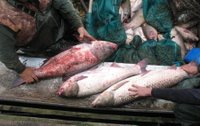
Three of the fish he is catching were not around in Louisiana waters when I was fishing. These would be the three carp laid out on the side of the boat: the bighead carp (the most massive), the silver carp (in the middle) and the grass carp (closest to the bottom). The bighead carp gets up to 90 pounds in Louisiana, I’m told, and is mostly a filter feeder. The open mouth shows the close arrangement of the gills that act to strain out very small organisms from the water column. Rusty says he has seen these big fish swimming slowly with their head upcurrent and their mouth wide open, filtering the water like the pictures of whale sharks show them doing.
The silver carp is a really pretty fish. It is classically fish-shaped and has all those very small scales. However, it is the one you see pictures of jumping out of the w
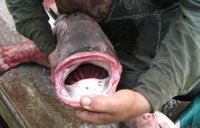
ater seemingly in response to the sound of outboard motors. With its size, it can knock you out of a boat and has been said to have caused some deaths related to the jumping. And we used to be concerned about getting hit by little mullet every once in a while. Ha.
The other fish, the long one with the big scales is the ill-famed grass carp. The one that was said to be the answer to the noxious plant problem in lakes like Caney Lake in north central Louisiana, where Hydrilla was choking the lake. The imported carp were supposedly sterilized and 12,000 of them were released into the lake. Within a short time, they had indeed eaten all the Hydrilla, and all of the other vegetation in the lake, leaving it bare and without the bass fishery it had been known for. There were stories of the hungry carp being seen at night with their heads and upper bodies pushed up on the lawns of lakeside property, grazing on the grass. To top it off, it turns out the sterilized carp were not truly sterilized after all, because they are now being found, like this one, in open rivers in Louisiana. Rusty says this is actually a good thing for him because the carp bring a good price at the dock, being prized by folks to the west of us as a good food fish. Look at this one; it’s like a fish sausage with a small head and tail. Very good ratio of meat to throw-away on this fish!
Right now the powers that be are trying to decide what to do about the Hydrilla infestation in Henderson Lake, right next door to us. Over a million dollars (I believe that’s a conservative figure) has been spent on controlling the plant, but apparently the grass carp-lesson is well learned. No one is suggesting that remedy that I know of. Ironically, the regulators working in Caney Lake are now trying to regrow Hydrilla to bring back some cover to

support the fishery they lost eliminating the Hydrilla in the first place. Go figure.
The grass carp lying across the boat rests upon some green sacks. This is cow feed that Rusty is using for bait in the nets. I will try that for the shrimp traps too.
Lastly, the two buffalo pictured here represent the two money-makers for buffalo fishermen. They are the bigmouth and smallmouth buffalo. They are what Rusty caught 3,300 pounds of to fill his boat earlier this week. The bigmouth is above and has the terminal mouth (at the very end of the face) and the smallmouth
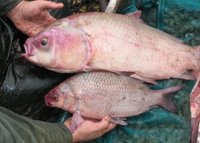
has its mouth sort of suspended underneath its face. It’s interesting to ask around the area for someone who eats buffalo – not easy to find someone who eats them. And yet someone does, the market for them says so. I have eaten them several times, and they make a really good courtboullion, but the intermuscular bones always seem to discourage a big following for them. Too bad, they taste fine.
Enough.
The NOAA river stage pages are not working right now. Will try to edit them in later.
Rise and Shine, Jim

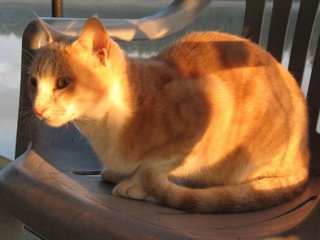 he fishing community. I couldn’t help but be amazed to see him doing this. Here was this young man who started by fishing with hooks for a living and now here he is officiating at one of the most important religious rites that we practice today. He is one of the people I think about when I wonder if I have the energy to persevere at some new thing that I want to do. I think of Joe and I have the courage to move ahead.
he fishing community. I couldn’t help but be amazed to see him doing this. Here was this young man who started by fishing with hooks for a living and now here he is officiating at one of the most important religious rites that we practice today. He is one of the people I think about when I wonder if I have the energy to persevere at some new thing that I want to do. I think of Joe and I have the courage to move ahead.







 has its mouth sort of suspended underneath its face. It’s interesting to ask around the area for someone who eats buffalo – not easy to find someone who eats them. And yet someone does, the market for them says so. I have eaten them several times, and they make a really good courtboullion, but the intermuscular bones always seem to discourage a big following for them. Too bad, they taste fine.
has its mouth sort of suspended underneath its face. It’s interesting to ask around the area for someone who eats buffalo – not easy to find someone who eats them. And yet someone does, the market for them says so. I have eaten them several times, and they make a really good courtboullion, but the intermuscular bones always seem to discourage a big following for them. Too bad, they taste fine.

